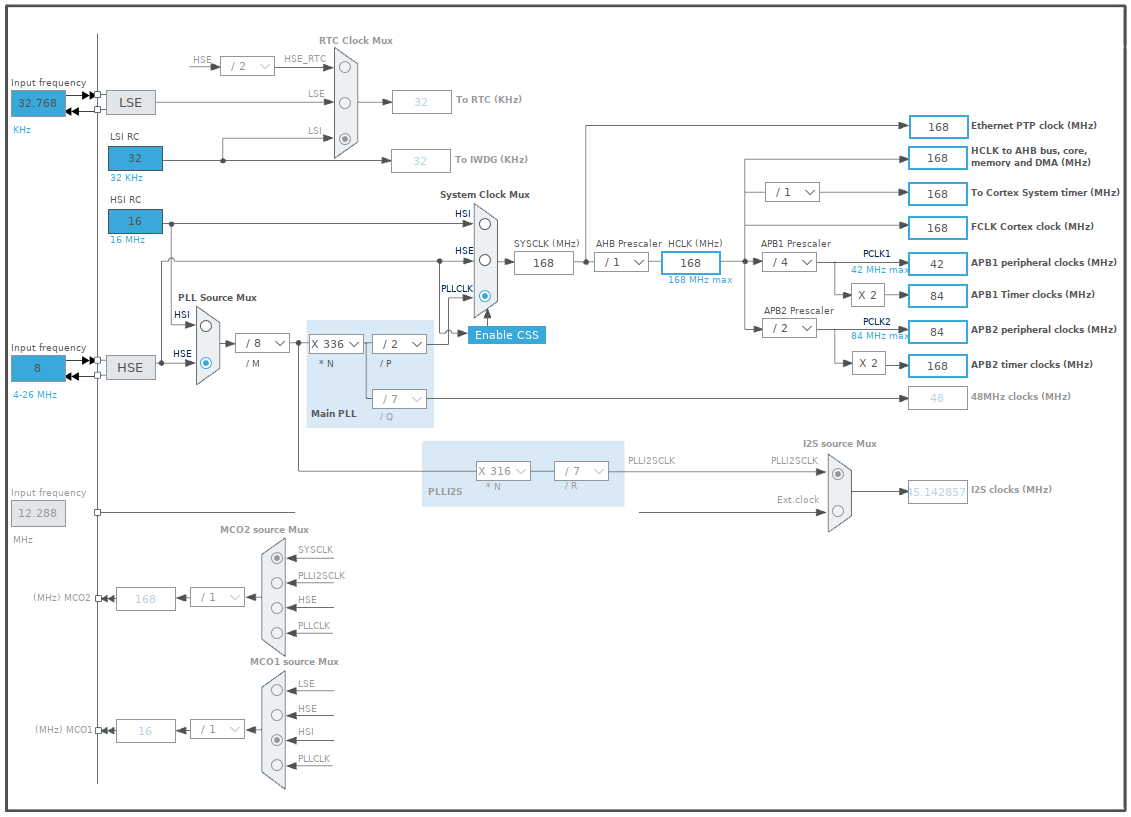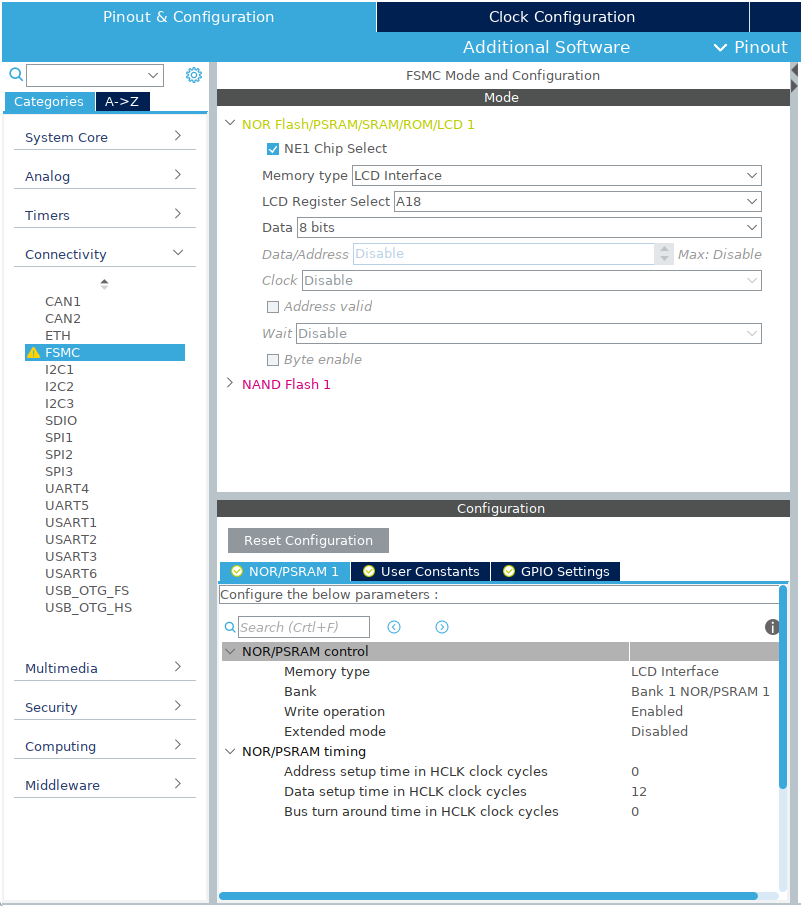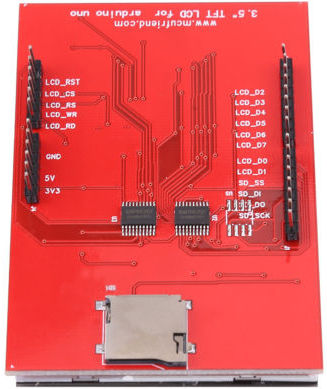3.5" inch TFT LCD Display Module 480X320 driven with FSMC.
TFT LCD Display Module 480X320 driven with FSMC
I have recently bought a 3.5" inch TFT LCD Touch Screen Display Module 480X320 with a www.mcufriend.com label on the back side. The display was equipped with an 8bit parallel interface. First I decided to test it with the UniGraphic library using the BUS_8 protocol. The display was very slow but improved when I switched to the PAR_8 protocol. Because I heard about the possibility to use a Flexible Static Memory Controller (FSMC), built into some STM MCU's, to drive LCD's (read/write to LCD's memory rather than to an external SRAM) I thought it would be a fun to try it out.

Below is the brief story of what I did:
- Created a project for my STM32F407VE board in the STM32CubeIDE
- Set the
Clock Configurationto match the one used by Mbed for the Seeed Arch Max board:
- Selected
FSMCin theConnectivitycategory and configured it as below:
- Let the
STM32CubeIDEgenerate the code (files). - Created a new program for the Seeed Arch Max target in the Mbed Online Compiler by selecting a
mbed os blinkytemplate. - Replaced the
main.cppwith themain.ccontent of theSTM32CubeIDEproject. Copy & Pastedthe other files with codes from theSTM32CubeIDEproject to the online compiler project.- Renamed and modified:
"stm32f4xx_it.h" to "stm32f4xx_it_msp.h"
"stm32f4xx_it.c" to "stm32f4xx_it_msp.c" - Added the UniGraphic library to the online compiler project.
- Extended the
UniGraphiclibrary with aFSMC_8protocol and replaced theTFT::set_orientation(int orient)function with the one used bymcufriendfor arduino. - Modified the
main.cppas needed.
 |  |
Wiring
| STM32F407VE | TFT LCD module |
|---|---|
| +3.3V | 3V3 |
| GND | GND |
| PB_12 | LCD_RST |
| GND | LCD_CS |
| PD_13 (RS) | LCD_RS |
| PD_5 (WR) | LCD_WR |
| PD_4 (RD) | LCD_RD |
| PD_14 (DB00) | LCD_D0 |
| PD_15 (DB01) | LCD_D1 |
| PD_0 (DB02) | LCD_D2 |
| PD_1 (DB03) | LCD_D3 |
| PE_7 (DB04) | LCD_D4 |
| PE_8 (DB05) | LCD_D5 |
| PE_9 (DB06) | LCD_D6 |
| PE_10 (DB07) | LCD_D7 |
Results
| Execution times | ||
|---|---|---|
| Used protocol | BUS_8 | FSMC_8 |
| Operation \ Time | ms | ms |
| Clear | 2283.980 | 38.454 |
| Plot | 192.066 | 11.365 |
| 8bit BMP | 63.805 | 41.338 |
| Large Font | 163.872 | 7.895 |
| Sparce pixels | 2072.265/1458.051 | 74.107/52.168 |
| 16bit BMP | 2288.589 | 59.904 |
Diff: UniGraphic/Inits/UC1608.cpp
- Revision:
- 0:fa952828e34c
--- /dev/null Thu Jan 01 00:00:00 1970 +0000
+++ b/UniGraphic/Inits/UC1608.cpp Sun May 10 10:44:31 2020 +0000
@@ -0,0 +1,100 @@
+ /* mbed UniGraphic library - Device specific class
+ * Copyright (c) 2015 Giuliano Dianda
+ * Released under the MIT License: http://mbed.org/license/mit
+ */
+#include "Protocols.h"
+#include "UC1608.h"
+
+//////////////////////////////////////////////////////////////////////////////////
+// display settings ///////////////////////////////////////////////////////
+/////////////////////////////////////////////////////////////////////////
+#define IC_X_SEGS 240 // UC1608 SEG has range 0-239 (239-0 if MX=1), check your datasheet, important for the orientation
+#define IC_Y_COMS 128 // UC1608 COM has range 0-127 (127-0 if MY=1), check your datasheet, important for the orientation
+//#define LCDSIZE_X 240 // display X pixels
+//#define LCDSIZE_Y 120 // display Y pixels, UC1608 is advertised as 240x128 but display size could be smaller
+
+
+
+UC1608::UC1608(proto_t displayproto, PortName port, PinName CS, PinName reset, PinName DC, PinName WR, PinName RD, const char *name , unsigned int LCDSIZE_X, unsigned int LCDSIZE_Y)
+ : LCD(displayproto, port, CS, reset, DC, WR, RD, LCDSIZE_X, LCDSIZE_Y, IC_X_SEGS, IC_Y_COMS, name)
+{
+ hw_reset();
+ BusEnable(true);
+ init();
+ cls();
+ set_orientation(1);
+ locate(0,0);
+}
+UC1608::UC1608(proto_t displayproto, int Hz, PinName mosi, PinName miso, PinName sclk, PinName CS, PinName reset, PinName DC, const char *name, unsigned int LCDSIZE_X, unsigned int LCDSIZE_Y)
+ : LCD(displayproto, Hz, mosi, miso, sclk, CS, reset, DC, LCDSIZE_X, LCDSIZE_Y, IC_X_SEGS, IC_Y_COMS, name)
+{
+ hw_reset();
+ BusEnable(true);
+ init();
+ cls();
+ set_orientation(1);
+ locate(0,0);
+}
+// reset and init the lcd controller
+void UC1608::init()
+{
+ /* Start Initial Sequence ----------------------------------------------------*/
+
+ // wr_cmd8(0xE2); // sw reset
+ wait_ms(15);
+
+ wr_cmd8(0x27); // Multiplex rate :128 set temperature consenpation 0%
+ wr_cmd8(0xEA); //set bias:1/12bias
+
+ wr_cmd8(0xC4); // set mirror MX=1,MY=0 (controller->display SEGs wiring inverted)
+ // wr_cmd8(0xA0); // ADC select seg0-seg223
+ //wr_cmd8(0xA1); // ADC select seg223-seg0
+ // wr_cmd8(0xC8); // SHL select com63-com0
+ //wr_cmd8(0xC0); // SHL select com0-com63
+
+ wr_cmd8(0x2F); // //Power Control:internal, LCD capacitance 60nf-90nf
+ wait_ms(10);
+
+ // wr_cmd8(0x81);//Set Gain and Potentiometer
+ // wr_cmd8(0x40|26);//Set Gain and Potentiometer xx xxxxxx
+ set_contrast(26);
+
+ wr_cmd8(0x88); //disable colum/page address wraparound
+ wr_cmd8(0xA4); // LCD display ram (EntireDisplayOn disable)
+ wr_cmd8(0x40); // start line = 0
+ wr_cmd8(0xA6); // display normal (1 = illuminated)
+ wr_cmd8(0xAF); // display ON
+
+}
+////////////////////////////////////////////////////////////////////
+// functions that overrides the standard ones implemented in LCD.cpp
+////////////////////////////////////////////////////////////////////
+void UC1608::mirrorXY(mirror_t mode)
+{
+ switch (mode)
+ {
+ case(NONE):
+ wr_cmd8(0xC4); // this is in real X mirror command, but my display have SEGs wired inverted, so assume this is the default no-x-mirror
+ break;
+ case(X):
+ wr_cmd8(0xC0);
+ break;
+ case(Y):
+ wr_cmd8(0xCC);
+ break;
+ case(XY):
+ wr_cmd8(0xC8);
+ break;
+ }
+}
+void UC1608::set_contrast(int o)
+{
+ contrast = o;
+ // wr_cmd8(0x81); // set volume
+ // wr_cmd8(0x40|(o&0x3F));
+ wr_cmd16(0x8140|(o&0x3F));
+}
+void UC1608::BusEnable(bool enable)
+{
+ LCD::BusEnable(!enable); // crap IC has CS not inverted (active HIGH)
+}
\ No newline at end of file